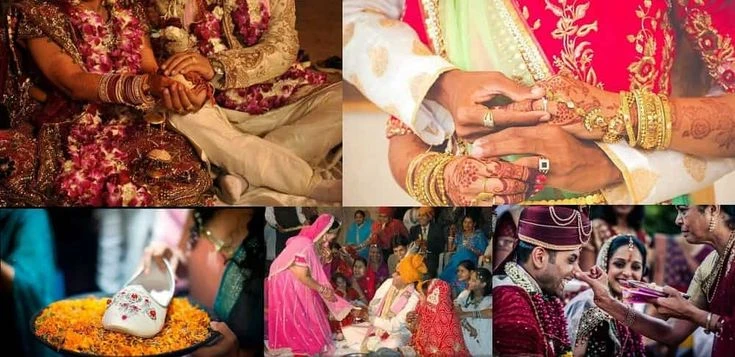
A Glimpse Into Gujarati Marriage Rituals: Tradition And Celebration
Gujarati weddings are renowned for their vibrant colors, rich traditions, and deep-rooted cultural rituals. These ceremonies, deeply embedded in the cultural heritage of Gujarat, are celebrated with a sense of grandeur and joy. Here's an overview of some key rituals and traditions observed in a traditional Gujarati marriage:
1. Matchmaking and Engagement (Mangal Phera)
The journey towards a Gujarati wedding begins with the process of matchmaking, often arranged by the families. Once the match is found, an engagement ceremony called Mangal Phera is held. This involves the families exchanging gifts and performing rituals to formally agree on the union. The engagement ceremony is usually accompanied by the exchange of rings and a feast to celebrate the upcoming wedding.
2. Pre-Wedding Rituals
a. Roka Ceremony: This is a formal announcement of the couple’s intention to marry. Both families gather to make the commitment official, and the bride and groom exchange gifts, sweets, and blessings.
b. Sagai: This is the engagement ceremony where the bride and groom exchange rings. It's often accompanied by a small celebration with close family and friends.
c. Mehendi Ceremony: Held a day or two before the wedding, this involves applying henna on the bride's hands and feet. It's a joyous occasion where female relatives and friends gather to celebrate and apply intricate mehendi designs.
d. Haldi Ceremony: During this ritual, a paste made of turmeric, sandalwood, and other ingredients is applied to both the bride and groom. This is believed to purify and beautify them before the wedding.
3. Wedding Day Rituals
a. Varmala/Varmala Ceremony: This is the first significant event on the wedding day. The bride and groom exchange floral garlands in a symbolic gesture of accepting each other. This is usually a lively and joyous occasion with lots of cheering and celebration.
b. Mandap Ceremony: The wedding ceremony takes place under a beautifully decorated canopy called the Mandap. This is where the primary rituals are performed.
c. Kanyadaan: This is one of the most touching rituals where the bride's father gives her away to the groom. The father places his daughter's hand into the groom’s hand, symbolizing the transfer of responsibility.
d. Saat Phere: The couple takes seven steps around the sacred fire (Agni) while making promises to each other. Each step signifies a vow or commitment in their married life.
e. Sindoor and Mangalsutra: The groom applies sindoor (vermilion) to the bride’s parting of hair and ties a mangalsutra (sacred necklace) around her neck. These acts signify the bride’s new status as a married woman.
4. Post-Wedding Rituals
a. Griha Pravesh: Upon arriving at the groom’s home, the bride is welcomed with a traditional ritual that involves stepping into the new home with her right foot first. She may also be greeted with a ceremonial aarti (a religious ritual of worship).
b. Reception: A grand reception is often held to celebrate the union with extended family and friends. This is a festive occasion with a lavish feast, music, and dance.
c. Vidaai: This is an emotional ritual where the bride bids farewell to her family and leaves for her new home. It signifies the transition from her parental home to her marital home.
5. Cultural and Regional Variations
Gujarati weddings may vary slightly depending on the specific community and region. For instance, the Lagna Patrika (wedding invitation) might be elaborately designed, and Padhvanu is a ritual where the newlyweds receive gifts from their elders.
Conclusion
A Gujarati wedding is a celebration of love, tradition, and family. Each ritual and ceremony is infused with symbolic meaning and reflects the cultural richness of Gujarat. From the joyous mehendi ceremony to the sacred saat phere, every aspect of the wedding is a tribute to the couple’s journey and their new beginning together

Related Posts